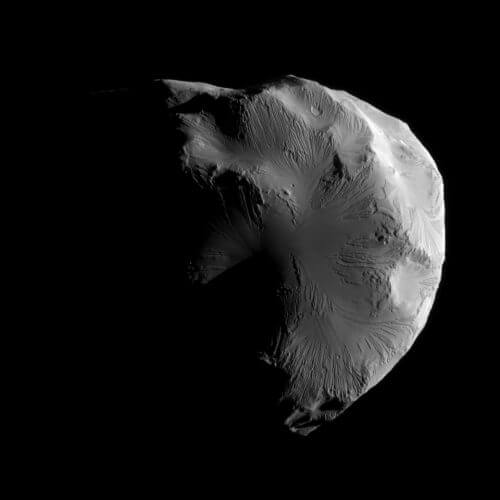Saturn's small moon Helene has been revealed over the years in several close-up images by the Cassini spacecraft.

This moon is one of dozens of moons orbiting Saturn. It was first photographed by the Voyager spacecraft and years later by the Cassini spacecraft. Cassini photographed it dozens of times. This is a body whose dimensions are 43.4 × 38.2 × 26 km. Its distance from Saturn is 377,400 km and it orbits it once every 2.73 days. Like other moons, it is also covered with craters. Some of the craters have a diameter of 10-1 kilometers and in relation to their dimensions they are large. Other craters are hundreds of meters in size and less. Part of its surface is covered with dust. Due to the strong light reflection of part of the surface, it is possible that there is water ice on it.
The photographs are highly detailed. This is thanks to the fact that Cassini's transit distances from it made it possible to take photographs in resolutions where many details can be discerned. For example, on 24.11.2008 the spacecraft passed at a distance of 68,000 km from it and the resolution was 408 meters per pixel. The shortest crossing distance was on 10.3.2010, 1829 km from it and the resolution tens of meters per pixel.
One of the most important photographs was on 18.6.2011, when the spacecraft passed at a distance of 7000 km from it and the resolution was 42 meters per pixel. In this photograph and others we see something completely new, channels (gullies), grooves reminiscent of those of the Mars moon Phobos, but different from them. The grooves of Mars are hundreds of meters long and those of Helen are very short. Dozens of meters and a rough estimate of their width is 30-20. They appear in clusters on the rim of craters and move along their slopes to low places. Water flow in them is not possible at all. Due to the tiny dimensions of this moon it is hard to believe that tectonic activity can occur on it. Maybe some sort of rock fall that hit the moon made these holes. The explanation is narrow, but at least there is now no better explanation for this phenomenon. (Author's explanation - Haim Mazar).
See more on the subject on the science website:
- NASA's Cassini spacecraft shows: three moons of Saturn in one day, December 9, 2015
- Pandora, a small moon of Saturn, has been revealed in new Cassini images, January 7, 2017
- Saturn's rings are revealed in unprecedented detail in new Cassini images, January 31, 2017
- Daphnis, a moon of Saturn, revealed in a new Cassini image, February 5, 2017
